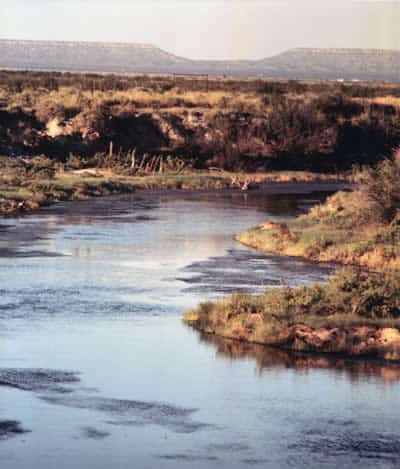Editor’s note-
The following article about Horsehead Crossing is authored by Patrick Dearen. Dearen has gained recognition for his knowledge of old-time cowboy life. In the late 1980s and early 1990s, he preserved the firsthand accounts of 76 men who cowboyed before 1932. These interviews (now preserved in the Archives of the Haley Library) along with decades of archival study, have enriched Dearen’s twelve novels and led to nine nonfiction books. His latest manuscript, a complete history on the subject of the Pecos River, is scheduled for publishing in the fall of 2015 by the University of Oklahoma Press. In March, the Academy of Western Artists will present him with an award for his latest novel “The Big Drift” which won its Elmer Kelton Fiction Book of the Year Award.
Horsehead Crossing
In an extraordinary link to the past that it seeks to preserve, the Haley Library has gained part ownership of historic Horsehead Crossing on the Pecos River.
The acquisition, consisting of a one-twelfth undivided interest in six sections of land in Crane County, arose through a donation by James L. Donnell of Fowlerton. A Cowman’s Award honoree in 2013, Donnell deeded the property to the library on September 1, 2014.
“Not only was he extremely generous, but he made a very historically significant gift,” said Brian McLaughlin, chairman of the Haley Library Board of Trustees. “One of our main focuses is the history of the range cattle industry in West Texas, and then we end up owning a piece of one of the most significant historical tracts in that regard. It’s amazing.”
Horsehead Crossing, located 40 miles south-southwest of Odessa, was a noted landmark on the Comanche War Trail, the U.S. Army Upper Road of 1849, the Butterfield Trail, and the Goodnight-Loving Trail. The six Haley sections are in close proximity to one another upstream and downstream of the crossing, with each including a half-mile of river frontage.
Only two sections are contiguous, but this 1,280-acre tract contains not only Horsehead, but the locations of the Butterfield Mail station, the onetime ferry, a U.S. Army encampment, a 13-grave cemetery, and a general camping ground. The other four sections hold identifiable stretches of historic roads, including the Butterfield and Goodnight-Loving trails.
Horsehead was the setting for so many Indian fights and other dramatic events that some historians believe the crossing exemplifies the challenges of pioneering the West.
“Horsehead Crossing should always be remembered,” noted Joe Allen of Comanche, who has conducted extensive ground research at Horsehead. “It was a household word in its heyday.”
Nineteenth-century stream conditions made the Texas stretch of the Pecos a dreaded river for pioneers, who cursed its sheer banks, quicksand, and dangerous currents. More moat than river, the Pecos was a daunting barrier to passage, but Horsehead at least offered hope.
“It was one of only a few places to cross the river,” said Allen. “The banks sloughed here, but not in most other places.”
Allen pointed out that Horsehead lies on almost a direct line between two vital watering points on the Comanche War Trail: the historic spring at Big Spring and Comanche Springs at Fort Stockton.
“Coincidental? Probably not,” he said. “During the mid-nineteenth century, it was certainly the best place to cross the Pecos from most anywhere in Texas if one was traveling west. It was the interstate crossing at that time.”
Even before the Donnell donation, the ties between Horsehead Crossing and the library were noteworthy. Indeed, much of what is known today about the ford’s history is due to the library’s archival holdings, said Haley director Pat McDaniel.
“The acquisition creates a solid connection between the library’s research assets and the physical, historic site,” said McDaniel. J. Evetts Haley’s “[library founder] research and historical writings of the trail drive era after the Civil War have been used by many researchers. To have the library become a partial owner of the actual site is a wonderful tribute to both Mr. Haley and Jim Donnell. We are most grateful.”
Among the library’s Horsehead-related items is an original letter by Oliver Loving. Written in the Brazos River country May 22, 1866, the holograph tells of Loving’s plan to start “for the mountains” of Colorado with cattle the following month. Other primary sources in the library relate that Loving pooled herds with Charles Goodnight and set out June 6 along what would be known as the Goodnight-Loving Trail. After a 79-mile drive across waterless barrens west of the Middle Concho, the thirst-crazed beeves stampeded over the steep bank adjacent to Horsehead. One hundred animals were lost.
Haley Library holdings that shed additional light on Horsehead include the J. Evetts Haley, Clayton W. Williams, and Patrick Dearen collections. The Haley Collection offers particular insight, as it comprises interviews about Horsehead that Haley conducted as early as the 1920s.
His March 27, 1946 interview with J. Arthur Johnson brings Horsehead’s history to life in a special way. Recorded on an early dictating device known as a SoundScriber, the interview allows researchers to hear Johnson relate in his own voice the challenges of ranching at the crossing in the nineteenth century. The TX Ranch (known as the Horsehead outfit), which Johnson assumed management of in 1887, controlled 25 to 40 miles of riverfront on both sides, including the newly acquired Haley sections.
“The headquarter ranch was about a mile up the river from Horsehead, right on the bank of the river,” said Johnson, who was born in 1860. “. . . [We] branded eight or nine thousand cattle a year.”
At the time of Haley’s interviews with men who actually experienced Horsehead’s treachery, the library wasn’t even a fanciful thought. Little did he realize that well into the next century, history would come full circle when the research institution he opened in Midland, Texas in July of 1976 would gain partial ownership of Horsehead itself.
“Isn’t that incredible?” observed McLaughlin. “History has an impact on the present day, and here’s proof of it.”

